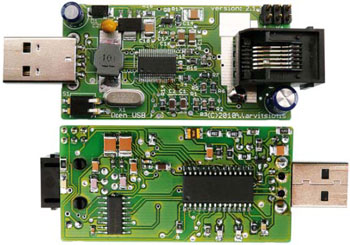Telefon/VoIP-Adapter mit Linux
Kochrezept: Etwas PIC, SLIC, Asterisk, Linux, FXS = keine Telefonkosten!

Bei diesem Hardware- & Software-Projekt geht es um ein USB-Interface für die VoIP-Telefonie mit einem analogen Telefon. Eine kompakte Platine plus Asterisk unter Linux und schon kann man ein Telefon anschließen und via VoIP preiswert telefonieren.
Dies ist ein NUR FÜR MITGLIEDER-Artikel. Um diesen Artikel lesen zu können, benötigen Sie ein Abonnement.
- Unbegrenzter Zugriff auf Member Only -Artikel
- 3 neue Ausgaben des Elektor Magazins (digital)
- Mehr als 5000 Gerber-Dateien
- 20% Mitgliederrabatt auf E-Books (auf elektor.de)
- 10% Mitgliederrabatt auf Produkte (auf elektor.de)
Erhältlich ab 6,33 € pro Monat.
Was ist Members Only
Elektor engagiert sich dafür, hochwertigen Inhalt rund um Elektronik bereitzustellen und betreut dabei zehntausende zahlende Mitglieder. Als Teil dieses Engagements hat Elektor das Premium-Angebot ins Leben gerufen, das exklusiven Zugriff auf ausgewählte Artikel bietet – manchmal sogar bevor diese in der Zeitschrift erscheinen.
Täglich können Mitglieder fundierte Artikel entdecken, die das Beste aus Elektors Premium-Content präsentieren und speziell darauf abzielen, ihr Wissen und ihre Begeisterung für Elektronik zu vertiefen.
Mit dem Premium-Programm will Elektor seiner Community aus Enthusiasten frühzeitigen Zugang zu aktuellen Projekten und Erkenntnissen ermöglichen. Nach dem Einloggen genießen Mitglieder diesen exklusiven Inhalt und können sich über spannende Projekte und Innovationen austauschen. Während Premium unser bestehendes Angebot erweitert, wird Elektor weiterhin eine Fülle an kostenlosen Informationen für die breite Community bereitstellen.
Werden Sie Teil der Elektor-Community und nutzen Sie Premium sowie weitere Mitgliedervorteile!
Material
Gerber-Datei
Die zu diesem Projekt gehörende Platine steht als Gerber-Datei exklusiv allen GOLD- und GREEN-Mitgliedern zum sofortigen Download zur Verfügung. Mit Gerber-Daten können Sie Platinen selber herstellen oder sie bei einem Platinenhersteller in Auftrag geben.
Elektor empfiehlt den zuverlässigen PCB-Service von Eurocircuits oder von AISLER.
Gerber-Dateien unterliegen der Creative Commons-Lizenz. Creative Commons bietet Urhebern die Möglichkeit, dass ihre Werke frei genutzt und verbreitet werden.
Stückliste
R1,R3,R5 = 200 k
R2,R4 = 196 k
R6,R7 = 4k02
R8,R9 = 470 Ohm
R14 = 40k2
R15 = 243 Ohm
R16 = 200 Ohm
R17 = 453 Ohm*
R18A,R18B = 0Ohm82*, SMD 1206
R19,R20 = 18 k
R21 = 15 Ohm, SMD 1206
R28 = 37k4
R29 = 453 k*
R32,RCLR, RPGM, RUSR = 10k
RL1 = 330 Ohm, SMD 1206
Kondensatoren (ohne Angabe: SMD 1206):
C1,C2,C31 = 10 ?/6V
C3,C4= 220 n/100 V, SMD 1812
C5,C6= 22 n/100 V, SMD 1812
C9 = 10 ?/100 V, radial
C10,C14,C26 = 100 n/100 V, SMD 1210
C15,C16,C17,C24,C30= 100 n, SMD 0603
C18,C19 = 4µ7/6V
C25 = 10 ?/25V, Tantal
C105,C106 = 680 p/100V
CDC1 = 100 ?/10 V, radial
CDC2 = 100 n/25 V
CO1,CO2 = 22 p
CUSB = 220 n
Spulen:
L1 = 100 ?H/1 A, SMD
L2,L3,L4 = 150 ?H/1 A, SMD, Typ BLM18AG601SN1, SMD 0603
Halbleiter (alle SMD):
D1 = ES1D (SMB)
IC1 = Si3210-FT/GT (TSSOP38-LP), SiLabs, Mouser 634-SI3210-GT
IC2 = Si3201-FS/GS (ESOIC-16T), SiLabs, Mouser 634-SI3201-GS
IC3 = PIC18F2550-I/SO, programmiert, Elektor 100761-41
LD1 = LED, grün (SMD 1206, Chip-LED)
Q7 = FZT953 (SOT230P700X160-4N)
Q8,Q9 = MMBT2222A (SOT95P280X13-3N)
Außerdem:
F1 = Sicherung 0A75, SMD 1210
J1 = RJ-11/12-Sockel für Platinenmontage
JLVP = Jumper (oder Drahtbrücke)
K1 = 6-pol. Stiftleiste (2x3), RM 0,1’’
S1 = 2-pol. DIP-Schalter, SMD
U1 = USB-A-H-Sockel
X1 = 20 MHz Quarz
Platine Elektor 100761-1
* für Telefonleitungen bis 700 m und V(ring) = 45 Vrms


Diskussion (0 Kommentare)